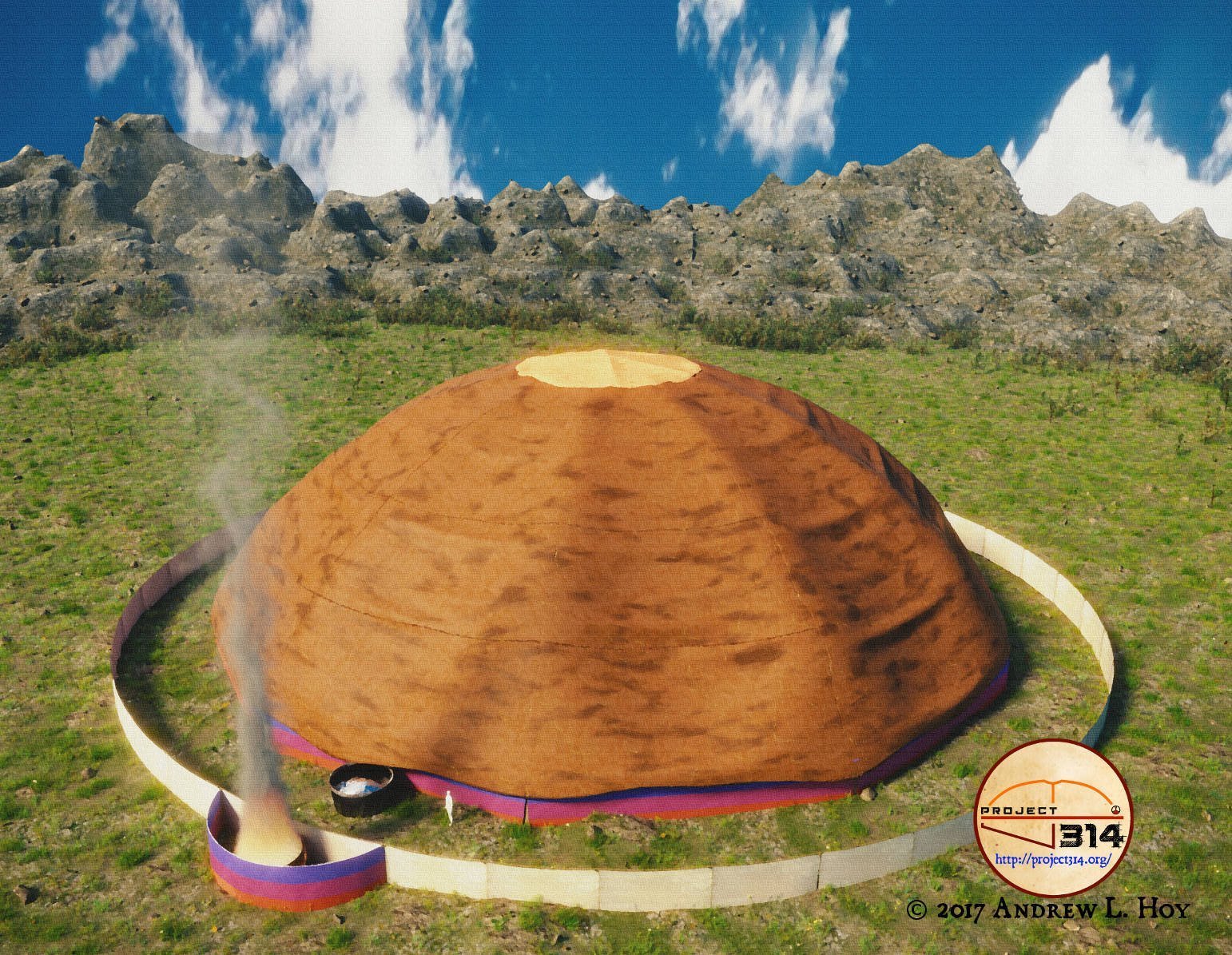The Tent of Appointed Times: Israel’s Clock, Calendar, and Compass
The last decade has not only seen its share of unique astronomical events—such as eclipse sets and prophetic planetary alignments in particular houses of the zodiac—it has also seen an exponential increase in public interest in the ancient Biblical calendar and return to celebration of Biblical holy days.
While skeptics might think that looking for heavenly signs is an unwarranted obsession or even an abomination with covert ties to pagan astrology, many Bible believers have come to embrace a radically different view and now see the sun, moon, and stars working together enigmatically as God’s master timepiece for mankind. Although this heavenly prophetic-clock concept may be neither familiar nor obvious to many modern Bible readers, it is of note that this simple principle is actually introduced without ambiguity or apology on the very first page of the Bible. Although the timekeeping purpose of the luminaries is slightly diminished in translation, King James’ Version of Genesis reads:
“And God said, ‘Let there be lights in the firmament of the heaven to divide the day from the night; and let them be for signs, and for seasons, and for days, and years…’”
– Genesis 1:14
According to the declaration above, the luminaries were created in part for the purpose of “seasons”; however, thinking of “seasons” as spring, summer, winter, and fall would be a gross oversimplification. After all, the original Hebrew word מועד (mô‛êd) conveys much more than changes in the solar cycle or annual weather patterns:
מועד – mô‛êd (Strong’s H4150): Properly an appointment, that is, a fixed time or season; specifically a festival; conventionally a year; by implication, an assembly (as convened for a definite purpose); technically the congregation; by extension, the place of meeting; also a signal (as appointed beforehand): – appointed (sign, time), (place of, solemn) assembly, congregation, (set, solemn) feast, (appointed, due) season, solemn (-ity), synagogue, (set) time (appointed).
In surveying the Strong’s concordance definition, it should be clear that the English word “season”—as it is typically used today—doesn’t convey the full essence of the Hebrew word מועד (mô‛êd). In fact, even in the four-hundred-year-old King James Version, מועד (mô‛êd) is only translated as “season(s)” a mere 5% of the time. Moreover, of the hundreds of uses of מועד (mô‛êd) in the Bible, the vast majority of them are not coupled to phenomenon such as weather, ecological cycles, and daylight, but rather are used in conjunction with Biblical festivals or “appointed times,” as demonstrated in the example below:
“Three times thou shalt keep a feast unto me in the year. Thou shalt keep the feast of unleavened bread: (thou shalt eat unleavened bread seven days, as I commanded thee, in the time appointed of the month Abib; for in it thou camest out from Egypt: and none shall appear before me empty:)”—Exodus 23:14-15
Upon further examination, it becomes apparent that the Hebrew מועד (mô‛êd) is found in the Bible in relatively limited contexts; more specifically, it is found making direct reference to Israel’s “Tabernacle,” which is often referred to as the “Tent of Meeting” or “Tent of the Congregation.” While the “Tabernacle” seems to be the preferred English term, it is of interest that the Bible precedent is otherwise. In other words, the “Tent of Meeting” or “Tent of the Congregation” title—which is qualified by the מועד (mô‛êd) term—is used more frequently than the “Tabernacle” term, which is translated from משכן (mishkân) (H4908) and generically refers to a “dwelling” or a “residence.” Thus, given the terminology and precedent, it is curious and perhaps somewhat problematic that this divine Exodus worship shelter is not referred to as a “Tent of Festivals,” a “Tent of Appointed Times,” or even a “Tent of Seasons.” After all, these ideas are much more encompassing and indicative of the tent’s purpose. Logically, it follows that if the tent is not titled and referenced in accordance with its usage and original Hebrew description, it is inevitable that its purpose will ultimately be overlooked or forgotten altogether.
So, given these two predominant Hebrew tent names, how might the tent’s true nature and purpose be understood? Is the Bible describing a crude shack or hut, as the Latin Taberna (root of Tabernacle) seems to imply, or was the tent to be a “dwelling place” or “residence,” as the Hebrew משכן (mishkân) conveys? Was the tent facility created for the purpose of an intimate meeting—like the kind you would have with a boss, colleague, or friend—as the “Tent of Meeting” title suggests? Or was the tent instead a place for gathering a large congregation of people and generically named the “Tent of the Congregation” after the group that funded and constructed it? What if the tent was much more? What if the tent was intended to be used for purposes of appointed times, dedicated meetings, congregational feasts, holy-day gatherings, and seasonal delineators as אהל מועד (‘ôhel mô‛êd) (H168, H4150) conveys in totality?
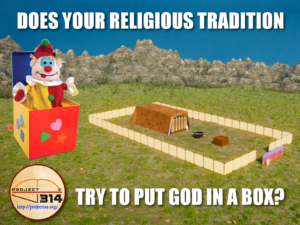 Unfortunately, when it is called according to its dysfunctional English namesake, the public at large is unlikely to perceive this “Tabernacle” to be divine or special in any way. To the contrary, just about any appreciation or endearment that is ascribed to the strange desert shack generally seems to be rather contrived, with people showing an artificial reverence for the dwelling place for the sake of duty or sense of loyalty toward the God of Abraham, Isaac, Jacob, and Moses. Given the fact that the Tabernacle fully occupies four full chapters in the book of Exodus and is referenced in no less than fifty chapters of the Bible, it is not unfair to wonder why religious enthusiasts and professionals are unlikely to give the subject matter attention in proportion to its Biblical mention. To the contrary, a simple survey of religious product catalogs and bookstore shelves silently tell the honest tale about the level of public appreciation for the Tabernacle—or lack thereof. Books that even incidentally refer to the Tabernacle are few and far between, and the short stack of titles that promise to offer insight on the subject matter begin by offering cartoon imagery or deferring to typology almost immediately, all while referencing a few verses, speaking very little of the structure itself, and treating Moses’ description as if it is meaningless or superfluous detail.
Unfortunately, when it is called according to its dysfunctional English namesake, the public at large is unlikely to perceive this “Tabernacle” to be divine or special in any way. To the contrary, just about any appreciation or endearment that is ascribed to the strange desert shack generally seems to be rather contrived, with people showing an artificial reverence for the dwelling place for the sake of duty or sense of loyalty toward the God of Abraham, Isaac, Jacob, and Moses. Given the fact that the Tabernacle fully occupies four full chapters in the book of Exodus and is referenced in no less than fifty chapters of the Bible, it is not unfair to wonder why religious enthusiasts and professionals are unlikely to give the subject matter attention in proportion to its Biblical mention. To the contrary, a simple survey of religious product catalogs and bookstore shelves silently tell the honest tale about the level of public appreciation for the Tabernacle—or lack thereof. Books that even incidentally refer to the Tabernacle are few and far between, and the short stack of titles that promise to offer insight on the subject matter begin by offering cartoon imagery or deferring to typology almost immediately, all while referencing a few verses, speaking very little of the structure itself, and treating Moses’ description as if it is meaningless or superfluous detail.
So what would happen if people would stop thinking of the Exodus tent apart from these traditional terms and consequential paradigms and start thinking of the tent as God’s residence or dwelling place, as a tent of congregational festivals, as a tent of appointed times, and as a tent of holy-day gatherings? … and what if people would come to think of the Mishkân or divine residence as something designed to mark different seasons and even function as God’s calendar?
The Exodus Tabernacle: God’s Holy-day Planner?
To think of the Tabernacle as the “Tent of Seasons” or as the “Tent of Appointed Times” may seem revolutionary and almost contrary to the expectations of religious orthodoxy. However, to do so is practical and even necessary if the great tent is to be understood in its full and authentic context. For example, it was during the spring equinox1—which was the first day of the first month of the Hebrew year following the Egyptian Exodus—that the Tabernacle was “appointed” to be erected (Exodus 40:2).
During this special “appointed time” of the year—known as the equinox or the first day of the month of Aviv—it just so happens that the morning sunrise and evening sunset would cast shadows perfectly in the due east and due west directions. When erecting the massive tent, this seemingly insignificant orientation detail would prove to be of particular importance, as the Tabernacle facility was specified to be aligned in very specific directions relative to the cardinal points of the compass.
Within just two weeks of the Tabernacle’s first setup, Israel would be ready to observe the first set of religious festivals of the year that fell in the first month of the Hebrew calendar, including the Feast of the Passover, the Feast of Firstfruits, and the Feast of Unleavened bread. With the exception of the spring feast of Shavuot, the reciprocal set of holy-day feasts were scheduled to begin on the first day of the seventh Hebrew month of the year, which coincided with fall equinox2. Obviously, detecting the exact time of the fall equinox (coinciding with the Yom Teruah, a.k.a., the Feast of Trumpets) could be accomplished in the same manner as it was during the spring equinox—by aligning two posts on opposite sides of the Tabernacle courtyard with the rising or setting sun on the horizon.
Introducing the Round Residence Paradigm
Apart from the tent and courtyard hardware alignments that could be either achieved or confirmed by equinox and solstice conditions, is it possible that the “Tent of Appointed Times” could facilitate calendar readings at any other point of the year based upon the position of the sun and perhaps the lesser luminaries? Although basic time and calendar approximation might be accomplished by means of the sun, a stick, and its shadow, to have the Tabernacle serve as an accurate and practical calendar or timepiece, the “Tent of Appointed Times” would ideally need to be two things: 1) large, and 2) round. However, according to the religious tradition, the ancient “Tent of Appointed Times” was neither large nor round, as conveyed by many different traditional Tabernacle drawings and models.
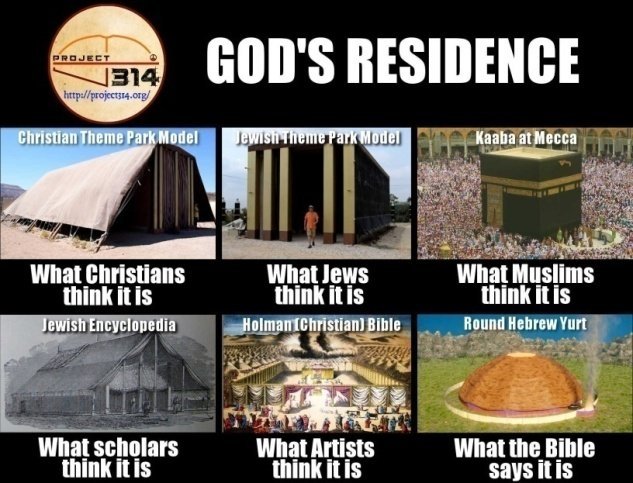 Although it is probably never considered, the term “traditional Tabernacle” is really an oxymoron of sorts. This becomes evident after surveying dozens, if not hundreds, of Tabernacle models as either drawn or constructed like those in the adjacent picture, where virtually no two “traditional” Tabernacle depictions are identical. While the models universally presume a rectangular floor plan and courtyard, the unfortunate and subtle reality is that these irregular and boxy shapes are not consistent with the chronometer capabilities as would be expected from a “Tent of Appointed Times.” To the contrary, the ancient tent has been linguistically relegated to a temporary and unsophisticated “meeting shack,” and Bible descriptions have been consistently and universally translated with biases and expectations—always assuming a rectangular layout. But a rectangular configuration is neither consistent with the original Hebrew descriptions nor with the recently rediscovered mathematical details which are inherent to the Bible texts.
Although it is probably never considered, the term “traditional Tabernacle” is really an oxymoron of sorts. This becomes evident after surveying dozens, if not hundreds, of Tabernacle models as either drawn or constructed like those in the adjacent picture, where virtually no two “traditional” Tabernacle depictions are identical. While the models universally presume a rectangular floor plan and courtyard, the unfortunate and subtle reality is that these irregular and boxy shapes are not consistent with the chronometer capabilities as would be expected from a “Tent of Appointed Times.” To the contrary, the ancient tent has been linguistically relegated to a temporary and unsophisticated “meeting shack,” and Bible descriptions have been consistently and universally translated with biases and expectations—always assuming a rectangular layout. But a rectangular configuration is neither consistent with the original Hebrew descriptions nor with the recently rediscovered mathematical details which are inherent to the Bible texts.
While religious traditionalists who are scarcely familiar with the English Exodus account might be quick to dismiss or even scoff outright at the notion of a round Exodus Tabernacle, there is nevertheless an abundance of evidence to support and fully endorse the conclusion. First and foremost, a number of simple proofs can be found in courtyard curtain descriptions, as described in Exodus 26:
And thou shalt make curtains of goats’ hair to be a covering upon the tabernacle: eleven curtains shalt thou make. The length of one curtain shall be thirty cubits, and the breadth of one curtain four cubits: and the eleven curtains shall be all of one measure. And thou shalt couple five curtains by themselves, and six curtains by themselves, and shalt double the sixth curtain in the forefront of the tabernacle. And thou shalt make fifty loops on the edge of the one curtain that is outmost in the coupling, and fifty loops in the edge of the curtain which coupleth the second. And thou shalt make fifty taches of brass, and put the taches into the loops, and couple the tent together, that it may be one. And the remnant that remaineth of the curtains of the tent, the half curtain that remaineth, shall hang over the backside of the tabernacle. And a cubit on the one side, and a cubit on the other side of that which remaineth in the length of the curtains of the tent, it shall hang over the sides of the tabernacle on this side and on that side, to cover it. (Exodus 26:7-13, KJV)
 In this short Exodus excerpt, eleven curtains measuring 30 x 4 cubits are described, each curtain being equipped with fifty loops at opposite sides for interconnection with an adjacent curtain. Traditionally, these curtains are assumed to be joined at the long edges, such that a 30 x 42 rectangular swatch is made (see Rectangular Wool Curtain Assembly figure). However, this traditional approach 1) fails to connect the curtains on the proper edges, and 2) fails to connect all of the edges. To the contrary, the edges are properly connected by using the “outmost” edges (i.e., the “warp”), or sometimes described as the “outermost” (i.e., farthest reaching) edges, or as more literally conveyed by the Hebrew, the “cut” edges—understanding that a long and narrow fabric strip would be woven in a loom at a fixed width using continuous cross thread (“weft”) and then “cut” to final length. Moreover, the eleven curtains are all woven with loops at opposite edges for interconnection with an adjacent one on each opposite side, which inherently requires that the curtains are joined in a way such that a ring or cylinder will be formed.
In this short Exodus excerpt, eleven curtains measuring 30 x 4 cubits are described, each curtain being equipped with fifty loops at opposite sides for interconnection with an adjacent curtain. Traditionally, these curtains are assumed to be joined at the long edges, such that a 30 x 42 rectangular swatch is made (see Rectangular Wool Curtain Assembly figure). However, this traditional approach 1) fails to connect the curtains on the proper edges, and 2) fails to connect all of the edges. To the contrary, the edges are properly connected by using the “outmost” edges (i.e., the “warp”), or sometimes described as the “outermost” (i.e., farthest reaching) edges, or as more literally conveyed by the Hebrew, the “cut” edges—understanding that a long and narrow fabric strip would be woven in a loom at a fixed width using continuous cross thread (“weft”) and then “cut” to final length. Moreover, the eleven curtains are all woven with loops at opposite edges for interconnection with an adjacent one on each opposite side, which inherently requires that the curtains are joined in a way such that a ring or cylinder will be formed.
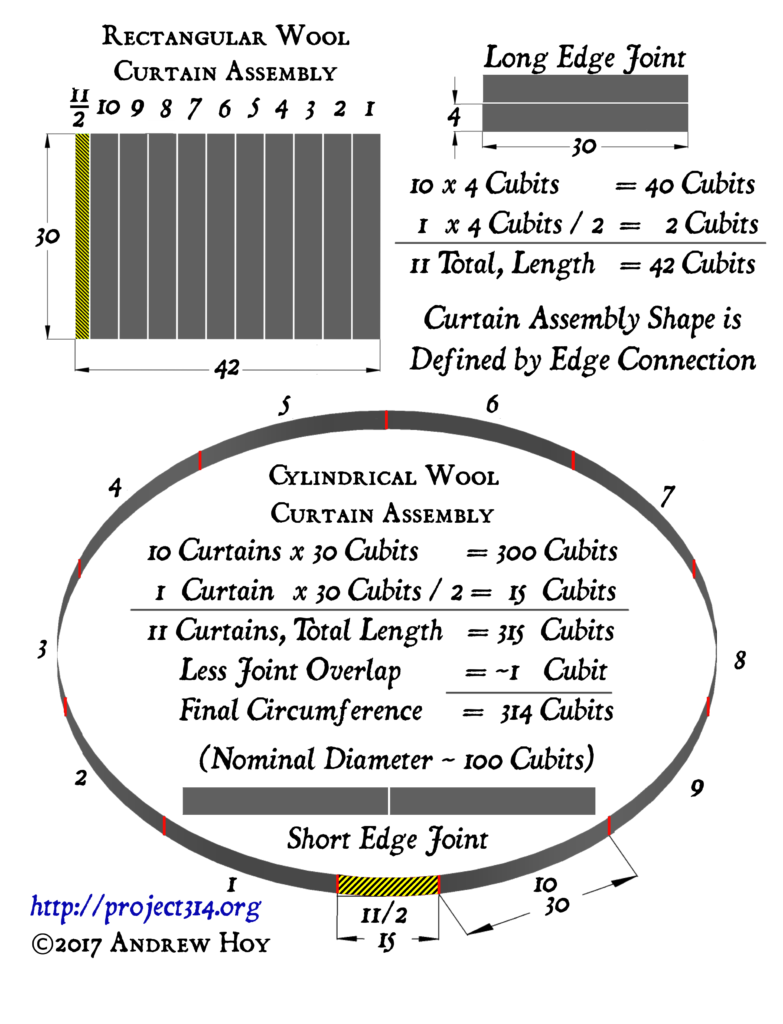 Perhaps of greater importance are the dimensions of the final assembly. As the eleven curtains measuring 30 cubits long are joined together, they would create a circumferential strip measuring 330 cubits; however, folding the last of the eleven curtains (reducing the sixth curtain from the second set from 30 cubits to 15 cubits per Exodus 26:9 &12) would reduce the assembled length to 315, and subtracting one cubit (accounting for the overlapping of end joints per Exodus 26:13) would make the final courtyard or “tent” dimension measure exactly 314 cubits! As 314 is a near perfect multiple of π—the mathematical constant that conveys the ratio between a circle’s circumference and its diameter—the dimensions all but insist that the final shape is round. After all, the Exodus texts include no provisions for leaving the last two strips open-ended or disconnected on one side.
Perhaps of greater importance are the dimensions of the final assembly. As the eleven curtains measuring 30 cubits long are joined together, they would create a circumferential strip measuring 330 cubits; however, folding the last of the eleven curtains (reducing the sixth curtain from the second set from 30 cubits to 15 cubits per Exodus 26:9 &12) would reduce the assembled length to 315, and subtracting one cubit (accounting for the overlapping of end joints per Exodus 26:13) would make the final courtyard or “tent” dimension measure exactly 314 cubits! As 314 is a near perfect multiple of π—the mathematical constant that conveys the ratio between a circle’s circumference and its diameter—the dimensions all but insist that the final shape is round. After all, the Exodus texts include no provisions for leaving the last two strips open-ended or disconnected on one side.
As this anomalous mathematical 314 sum and curtain connection detail has been overlooked while remaining hidden in plain sight for thousands of years, people have made embarrassing assumptions as to what type of tent is being described in Exodus, as well as how it is to be assembled. While it is virtually impossible to pinpoint the historical origin of this folly after Solomon decommissioned this divinely inspired and mandated wilderness tent, ascribing blame will hardly serve as a proof or validate the discovery. However, it is also far outside the scope of this article to offer dozens of proofs and explain, in great detail, the “how” and “why” this discovery is more than a mere hypothesis, a work of creative latitude, or the product of an overactive imagination. For those wanting more understanding of the holy residence or dwelling place, I would encourage them to explore Project 314 materials, including my recently released book and upgraded website (details below). Nevertheless, the balance of this article is predicated on this research and on the principle that the Tent of Meeting is not only a round dome, but actually a Tent of Appointed Times and a prophetic timepiece.
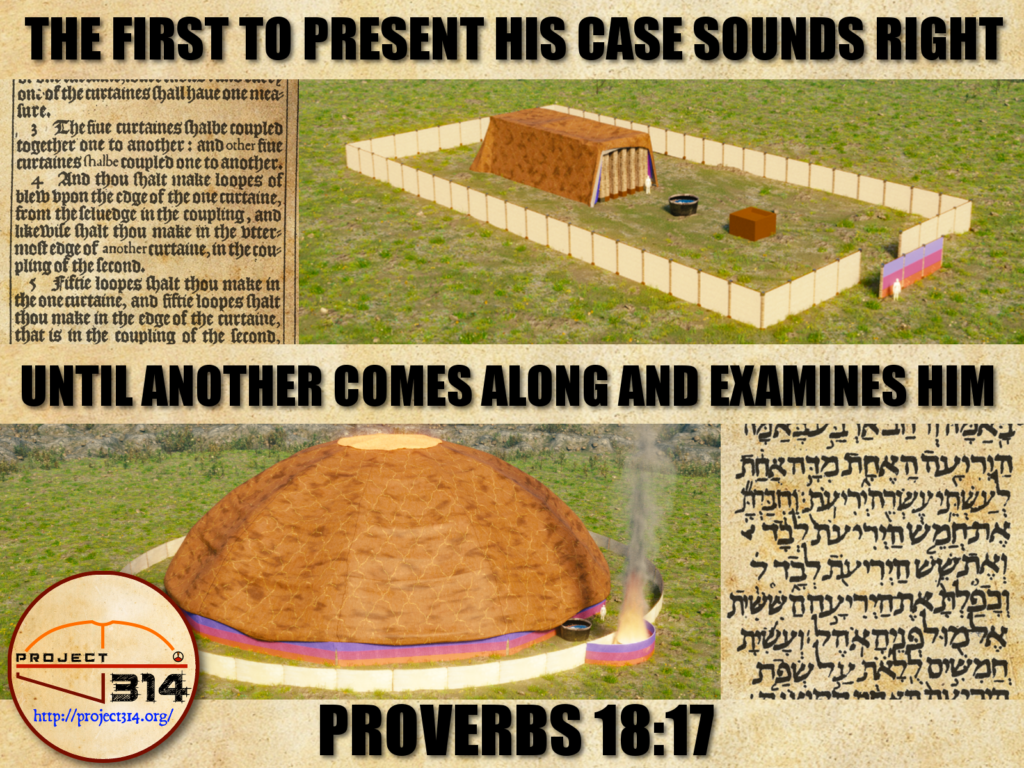
The Exodus Tabernacle: God’s Mobile Calendar and Compass?
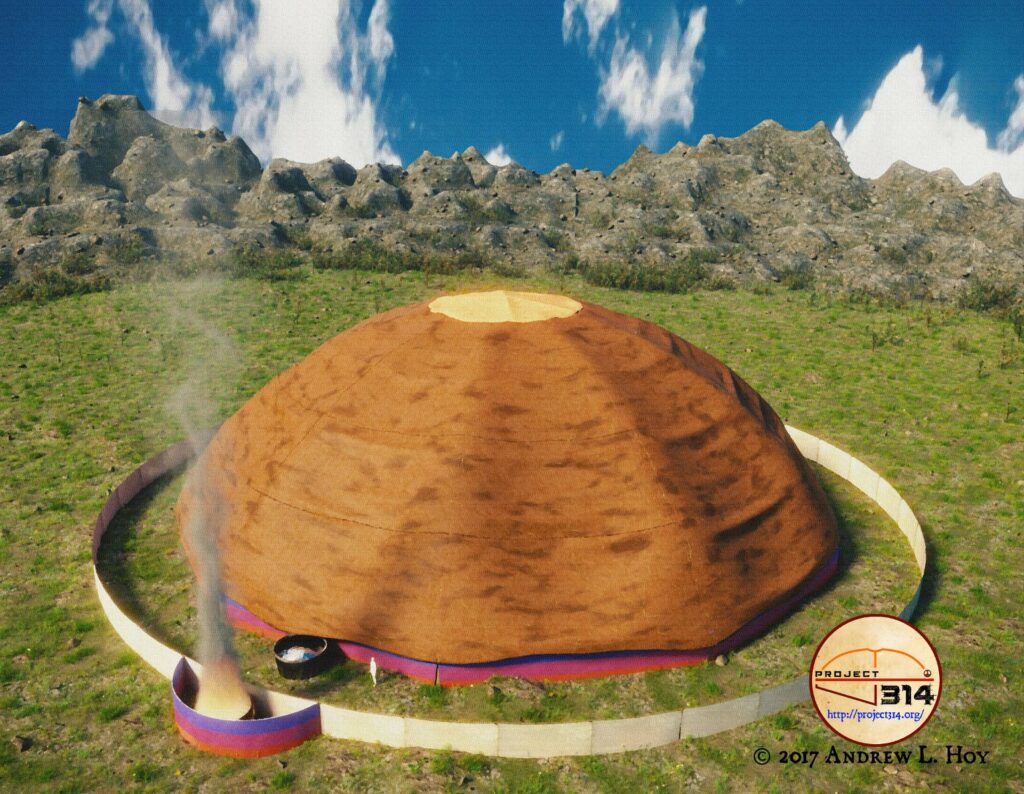 By beginning with the assumption that the Tabernacle is not only round, but also a timepiece, the “Tent of Appointed Times” title and hardware arrangement of the divine residence begins to make more sense. After all, the Hebrews took meticulous care in aligning the tent frame and the large round courtyard, and with this large courtyard—which is believed to have measured about 210 feet in diameter—they would have been able to measure the angular position of the sunrise and sunset on the horizon very accurately. In fact, if they were to use the outer courtyard rail for measurement—situated slightly above eye level—they could measure the sun’s position to within inches on the frame, which would equate to a fraction of a degree on the compass. Such measurements would also give them the ability to determine the exact day of the solar year, perhaps with an accuracy of mere hours.
By beginning with the assumption that the Tabernacle is not only round, but also a timepiece, the “Tent of Appointed Times” title and hardware arrangement of the divine residence begins to make more sense. After all, the Hebrews took meticulous care in aligning the tent frame and the large round courtyard, and with this large courtyard—which is believed to have measured about 210 feet in diameter—they would have been able to measure the angular position of the sunrise and sunset on the horizon very accurately. In fact, if they were to use the outer courtyard rail for measurement—situated slightly above eye level—they could measure the sun’s position to within inches on the frame, which would equate to a fraction of a degree on the compass. Such measurements would also give them the ability to determine the exact day of the solar year, perhaps with an accuracy of mere hours.
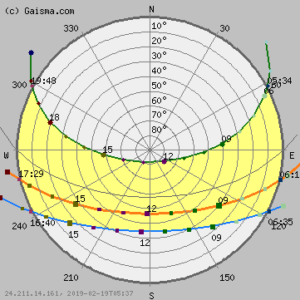 By using this “Tent of Appointed Times,” it stands to reason that the Hebrews would also have the ability to determine their geographic location during their wilderness wanderings. Given the sunrise and sunset position on the horizon, as well as the day of the year and the location of the heavenly bodies (e.g., angle of inclination), the Hebrews could determine their latitude. Likewise, as they would accurately establish the cardinal compass points, it stands to reason that they could have used this information—along with scouts providing survey data of their travel path lengths and bearings—to approximate their longitude (perhaps beginning with Mount Sinai as a known landmark). This would make sense, as the notion of an appointed place is also integral to the original מועד (mô‛êd) definitions (Strong’s H4150). Thus, the “Tent of Appointed Times” would double as a “Tent of Appointed Places” as well, being not only the place to be located for the appointment, but also a place from which other appointments could be made, based upon the placement of the heavenly bodies.
By using this “Tent of Appointed Times,” it stands to reason that the Hebrews would also have the ability to determine their geographic location during their wilderness wanderings. Given the sunrise and sunset position on the horizon, as well as the day of the year and the location of the heavenly bodies (e.g., angle of inclination), the Hebrews could determine their latitude. Likewise, as they would accurately establish the cardinal compass points, it stands to reason that they could have used this information—along with scouts providing survey data of their travel path lengths and bearings—to approximate their longitude (perhaps beginning with Mount Sinai as a known landmark). This would make sense, as the notion of an appointed place is also integral to the original מועד (mô‛êd) definitions (Strong’s H4150). Thus, the “Tent of Appointed Times” would double as a “Tent of Appointed Places” as well, being not only the place to be located for the appointment, but also a place from which other appointments could be made, based upon the placement of the heavenly bodies.
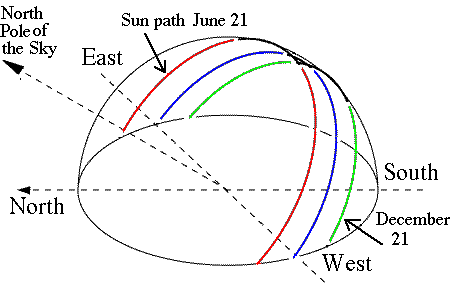 Of course, the Tabernacle’s geographical location was ultimately directed by the cloud, or pillar of fire, standing overhead, but having the ability to definitively know their wilderness location would possibly prove to be useful for some and perhaps comforting for others, with them knowing that they weren’t necessarily lost just because they were wandering. With the “Tent of Appointed Places” being at the center of a camp that hosted perhaps two million men, women, and children, it is also of note that the formidable Tabernacle would be able to give everyone nearby a sense of where they were parked. No doubt, the tent would have proven to be useful for the Israelites’ in-camp navigation, with the massive Tabernacle serving not only as a landmark that could be seen for miles (corresponding with the space required to host Israel’s multitudes), but also as a means of determining individual and tribal orientation throughout the camp.
Of course, the Tabernacle’s geographical location was ultimately directed by the cloud, or pillar of fire, standing overhead, but having the ability to definitively know their wilderness location would possibly prove to be useful for some and perhaps comforting for others, with them knowing that they weren’t necessarily lost just because they were wandering. With the “Tent of Appointed Places” being at the center of a camp that hosted perhaps two million men, women, and children, it is also of note that the formidable Tabernacle would be able to give everyone nearby a sense of where they were parked. No doubt, the tent would have proven to be useful for the Israelites’ in-camp navigation, with the massive Tabernacle serving not only as a landmark that could be seen for miles (corresponding with the space required to host Israel’s multitudes), but also as a means of determining individual and tribal orientation throughout the camp.
The Exodus Tabernacle: God’s Mobile Watch?
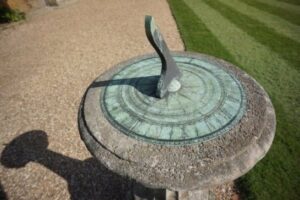 If the heavenly luminaries are considered to be God’s calendar or grandfather clock, the Tabernacle might be thought of as God’s traveling wristwatch. Understanding that the heavenly bodies move slowly in the sky relative to the earth, it is generally difficult to detect or measure small changes or periods of time. However, with a relatively large observatory or sundial, tracking time with more precision isn’t such an arduous task. Although the Israelites probably weren’t on tight schedules while encamped around the Tabernacle, it is nevertheless of note that with the “Tent of Appointed Times” apparatus they could have tracked time by the minute.
If the heavenly luminaries are considered to be God’s calendar or grandfather clock, the Tabernacle might be thought of as God’s traveling wristwatch. Understanding that the heavenly bodies move slowly in the sky relative to the earth, it is generally difficult to detect or measure small changes or periods of time. However, with a relatively large observatory or sundial, tracking time with more precision isn’t such an arduous task. Although the Israelites probably weren’t on tight schedules while encamped around the Tabernacle, it is nevertheless of note that with the “Tent of Appointed Times” apparatus they could have tracked time by the minute.
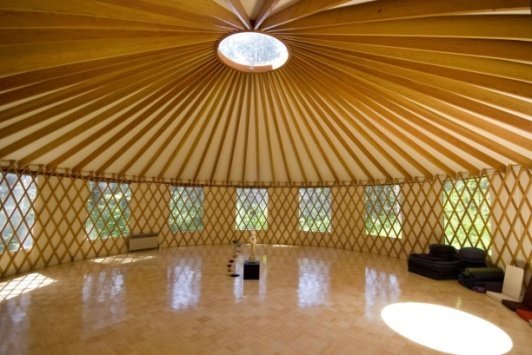 After erecting the large domed structure, the Hebrews could have employed their “Tent of Appointed Times” as a sundial in one of two ways. First, they could have used the oculus or ring while on the inside of the tent, which would admit a beam of sunlight that could be measured and tracked on the floor or the wall of the tent. While many modern yurt owners are well aware of this phenomenon, this idea is hardly anything new. In fact, Rome’s 2000-year-old Pantheon seems to be constructed with this very phenomenon in mind, as the builders appear to have deliberately engineered a prominent opening within the walls to be illuminated at certain times and seasons.
After erecting the large domed structure, the Hebrews could have employed their “Tent of Appointed Times” as a sundial in one of two ways. First, they could have used the oculus or ring while on the inside of the tent, which would admit a beam of sunlight that could be measured and tracked on the floor or the wall of the tent. While many modern yurt owners are well aware of this phenomenon, this idea is hardly anything new. In fact, Rome’s 2000-year-old Pantheon seems to be constructed with this very phenomenon in mind, as the builders appear to have deliberately engineered a prominent opening within the walls to be illuminated at certain times and seasons.
While it is possible to track a bright spot of sunlight on the inside of the dwelling place when the sun is overhead, it is also possible to track the shadow that is cast on the exterior of the structure during the wintertime or during the morning or afternoon hours. In this regard, the “Tent of Appointed Times” might be compared to the world’s largest sundial in Jaipur, which measures 90 feet tall and has a shadow that travels at around 1 milimeter per second, or 2-1/3 inches per minute. While not quite reaching the same height, shadows and light beams of the “Tent of Appointed Times” might travel at about two-thirds the speed, which would easily permit the tracking of time within a one-minute interval.
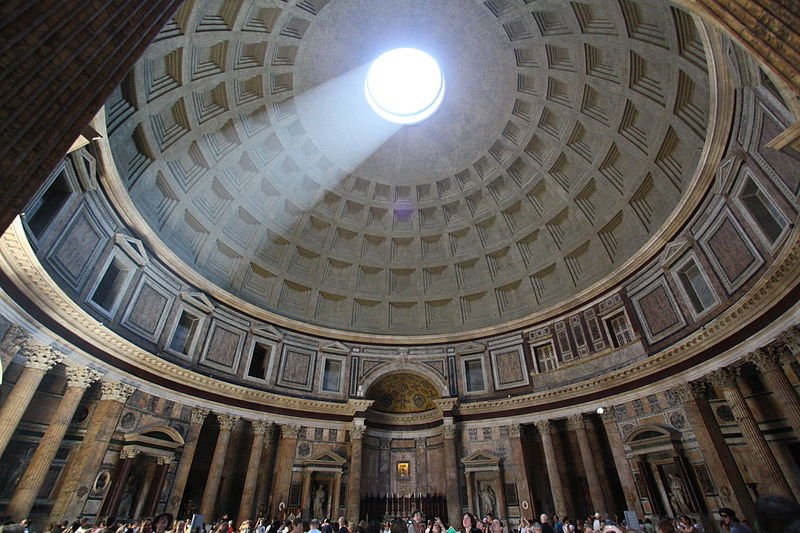
Measure the Pattern: The “Tent of Prophetic Times”
As the proper arrangement of the Tabernacle is made known, the imagery, typology, and implied prophecy conveyed by the divinely inspired structure also begins to make more sense. For example, the courtyard is comprised of wool curtains, which are courted by framework that is largely comprised of copper posts and copper rods. Often times, goats are associated with judgment or sacrifice (e.g., the Yom Kippur “scapegoat”), which takes place just outside of the courtyard at the entrance of the tent of meeting (Leviticus 16:7). Similarly, copper is known in the Bible as נחשת (nechôsheth) (Strong’s H5178), which is like the serpent or נחש (nâchâsh) (Strong’s H5175), in that both of them coil into a ring shape quite readily, and both are associated with judgment (Genesis 3:14, Numbers 21:9, Deuteronomy 28:23).
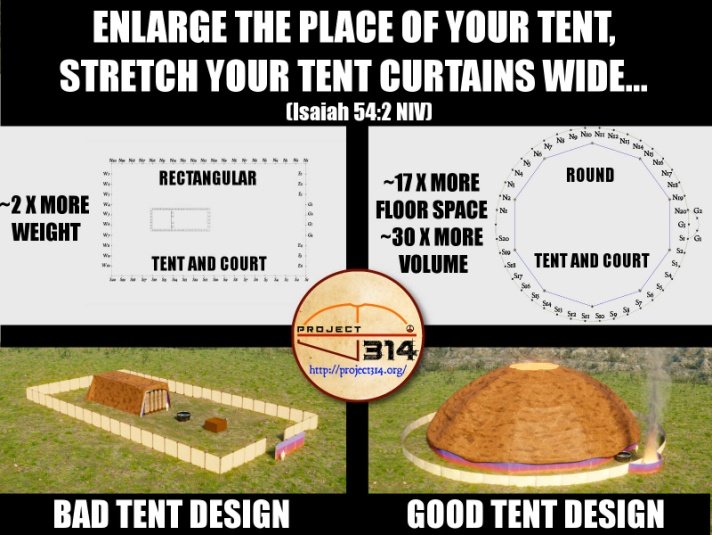
The principle of judgment outside the “Tent of Appointed Times” courtyard isn’t only conveyed by sacrificeactivity or material typology. The numbers—both quantities and measurements—also seem to tell a story. In the book of Daniel, there are two mentions of “time, times and a half” (Daniel 9;27, Daniel 12:7), which is understood to equal 42 months. Assuming a traditional courtyard model, the significant time periods cannot be correlated. However, given a proper understanding of the courtyard’s 314-cubit perimeter and the 42 posts which surroundthe holy dwelling place, the numbers begin to correlate and come into focus unlike ever before. For example, the Levitical cities—where Israel’s priests would fill the role of circuit court judges—numbered 42 (Numbers 6-7, Numbers 35:6), King Saul ruled for 42 years (1 Samuel 13:1), 42 men were destroyed after mocking Elijah (2 Kings 2:24), 42 thousand Ephraimites died in civil war (Judges 12:6), 42 members of Ahab’s family were executed (2 Kings 10:14), and exiles returning from Babylon were approximately 42 thousand (Ezra 2:64, Nehemiah 7:66). Likewise, both Matthew and Luke genealogies identify 42 generations, and the children of Israel had 42 sojournings in the desert until they finally were given rest (Numbers 33:1 – 50). Curiously, the π constant is also implied by the number 42, in that 42 is the product of 3 x 14.
Of course, it is impossible to see the significance of the 42-post count when examining the traditional rectangular model (which typically assumes that somewhere between 56 and 64 courtyard posts are used); similar perception improvements become apparent when examining the courtyard curtain-barrier arrangements under the round tent paradigm. For example, given that there are twelve tribes of Israel, one might expect to see a courtyard comprised of twelve curtains surrounding the tent. While it is true that the round outer courtyard perimeter is created by eleven curtains (Exodus 26:7-13), it is also of note that twelve curtains surrounded the ancient tent of appointment—provided that the special gate curtain, measuring 20 cubits, is included in the count. Incidentally, the last one of the eleven courtyard curtains is folded in half at the gate entrance, which might be compared to Joseph and Benjamin—the last of the sons of Israel to be born. Being two-fold but cut from the same cloth, they further resemble the tribe of Joseph—which became known by Joseph’s two sons, Ephraim and Manasseh, who were Jacob’s grandsons. Of course, the number 30 (conveyed by the courtyard curtain length) also corresponds with the day count of a Biblical month, as defined by a synodic lunar period (which currently is slightly over 29.5 days) or perhaps with perfect 30-day lunar periods, as recorded by the peoples of antiquity.
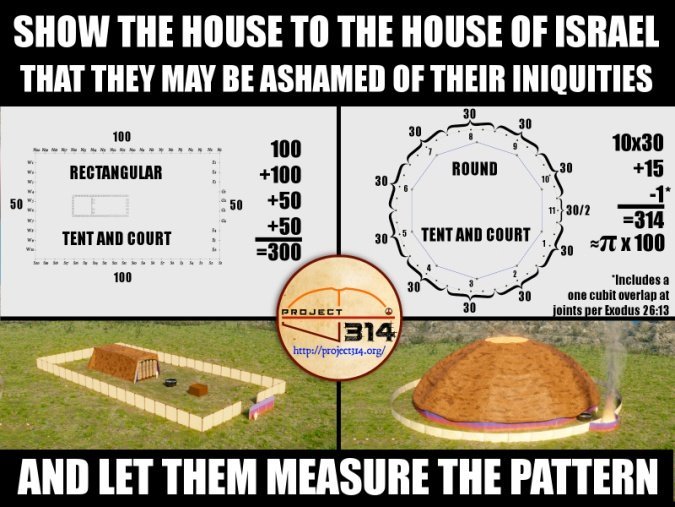
With the proper configuration of the posts and the curtains, the loops used for curtain joints might be put into a different perspective as well. Given that each loop of the 50-loop set represents one year, it stands to reason that the 50 loops are intended to correspond with a Jubilee cycle (Leviticus 25), but how so? Were the ten primary courtyard curtains—each with two sets of 50 loops on each end (or 50 curtain cords spanned between forty posts)—intended to represent a millennial cycle (excluding the gate)? Should the 50-loop sets of two adjacent curtains be assumed to be overlapping, as some believe the first and last year of the jubilee to be?
How about the courtyard gate entrance, a screened curtain measuring 20 cubits long, spanned in three sections between four posts? The measurement or span between these posts becomes 20/3=6.66… Of course, bound by this entrance curtain, there is a copper altar that is set ablaze in order to “burn the beast.”
Apart from the curtains, what can be said about the quantity of metal members used in the courtyard? A total of 100 talents of silver is used to make 100 silver parts that each weigh one talent (Exodus 38:27), but a mere 1775 talents of silver (perhaps about 40 pounds) is used to make the silver parts that join the courtyard posts and rods together. Understanding that there is just one silver part per post and that there are 20 southern posts, 20 northern posts, and 4 gate posts, this yields a sum of 144 silver units—which might be likened to the thousands who are redeemed, especially as silver is known to be associated with redemption.
The traditional non-circular Tabernacles are modeled in such a way whereby nobody is able to consistently quantify the copper hardware items, which (apart from the water laver) were made from about 70 talents of copper. Into how many pieces of copper is this sum divided? Contrary to the Scriptures, the traditional courtyard models are often assumed to employ wood courtyard posts (wood is not included in the Exodus 27:9-19 courtyard material list), which are believed to be secured to the ground with an arbitrary number of copper stakes. Consequentially, when tracking copper item inventories in traditional rectangular models, it seems that the perceived need for copper curtain rods (on which to hang the curtains) varies, as does the quantity of posts and rods forming the courtyard perimeter. On the other hand, by embracing the round “Tent of Appointed Times” paradigm, the proper quantification of courtyard posts and spanning rods becomes obvious and non-negotiable, and thus, copper parts are sensibly quantified:
50 Taches (Exodus 26:11)
44 Posts and
44 Curtain rods (including four for the gate, Exodus 27:9-19)
5 Five curtain rods (for the inner screen, Exodus 26:37)
+ 1 Burnt altar (Exodus 27:1-8)
=144 Copper items
What might these silver and gold part counts convey? Could it be that there are 144 thousand elect (silver) that are redeemed and inside of God’s dwelling place, while there are also 144 thousand elect (copper) that are used for judgment, most of which are outside the “Tent of Appointment”? Interpretations may vary and be influenced by personal opinion, experience, or perspective, but a divine pattern’s ability to convey principles and stories should hardly be disputed.
Returning to God’s Dwelling & Appointed Times
In concluding this brief introduction to God’s “Tent of Appointments” or אהל מועד (‘ôhel mô‛êd) (H168, H4150), it should be clear that the מועד (mô‛êd) are not limited to dates associated with religious holy days. The מועד (mô‛êd) more comprehensively encompass special places, people, and purposes, not merely seasons, holy days, dates, and times. It is important that none of these things are favored at the expense of the others, and it is also important to consider that the מועד (mô‛êd) term encompasses things past, present, and future.
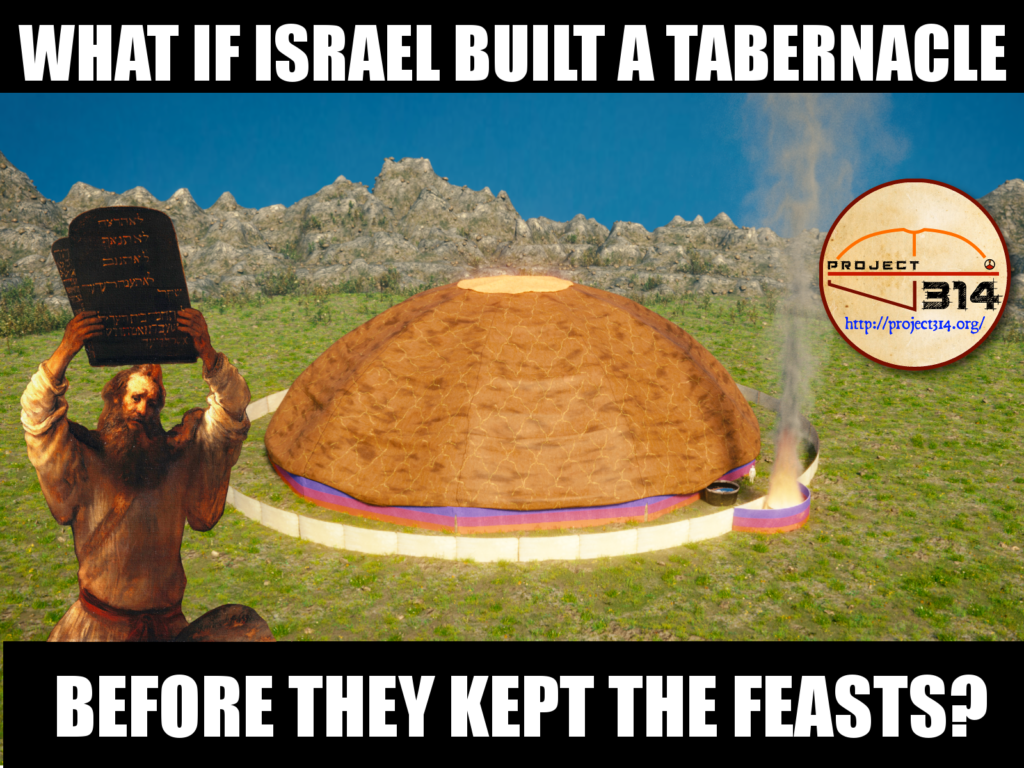
What was the pattern that Moses was “shown on the mountain”? Could it be that the 314 discovery is not only the key to unlocking God’s residence, but also a key to decrypting untold layers of hidden knowledge? What if understanding latter Bible texts is predicated on understanding the second book of the Bible, explaining subjects like the Hebrew calendar, prophecy/eschatology, typology, numerology, etymology, gematria, human anatomy, sacrifice, the priesthood, and messiah in ways like never before?
For those wanting more information about the pattern of this ancient tent, my latest books, The House of El Shaddai – God’s Dwelling Place Reconsidered (Hardcover, Softcover, and Workbook) and PowerPoint Presentation are now available via my website, https://project314.org/, or via amazon.com.
For those interested in further supporting Tabernacle research, development, and construction, consider supporting Project 314 for inside teachings, news, and updates.
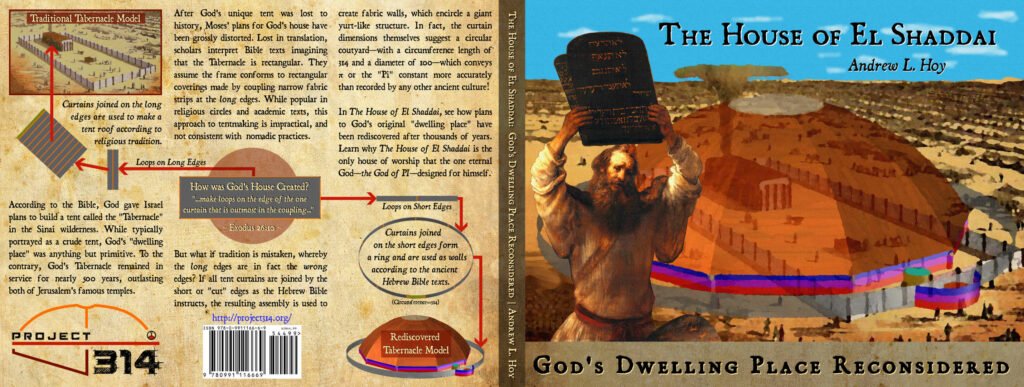
Footnotes:
1) According to Immanuel Velikovsky’s best-selling book, Worlds in Collision, many of the ancient cultures recorded a 360-day solar year, with a 30-day lunar cycle (a synchronized solar-lunar calendar that accounts for equinoxes always falling at the beginning of the month). An excerpt from Velikovsky’s work is as follows: “The ancient Vedas of India showed a 360-day year in the Brahmanas and they record that the moon waxed for 15 days and waned for 15 days in a month. The Brahmanas also state that the sun moved north 180 days and moved south 180 days in a year. In a later period, the Vedas record that the year was reformed to 365 1/4 days. In ancient Persia, the calendar had 360 days; later, it was reformed to add 5 Gatha days to the year length. The Sumerians had a 360-day year with months of 30 days, and the Babylonians adopted that Sumerian calendar. At the beginning of the 7th century BC, Babylon added 5 days to the year length. In ancient Assyria, the clay tablets from the royal library in Nineveh showed a 360-day year with 30-day months, and that the spring equinox always fell on Nisan 15. In Ancient Egypt, the Canopus Decree and Ebers papyrus calendar had 30-day months and a 360-day year. The year change occurred in the 8th or 7th century BC according to Plutarch and the Book of Sothis, with 5 epagomena days added to the year length.The Mayans of Mexico and Incas of Peru in Central and South America had a 360-day year calendar; later they added 5 1/4 days to the calendar. Other cultures like China and Polynesia had 360-day calendars that they amended by adding 5 days to the year–China called their added 5 1/4 days, Khe-ying days.”
2) The book of Genesis and the book of Kings seem to coincide with secular/pagan culture testimonies above. Genesis records five months (Genesis 7:11, Genesis 8:3-4) as spanning 150 days (Genesis 7:24), and Hezekiah records the sun traveling backwards on the sundial (2 Kings 20:9-11), which corresponds with other 7th-century BC records cited above in footnote 1.
